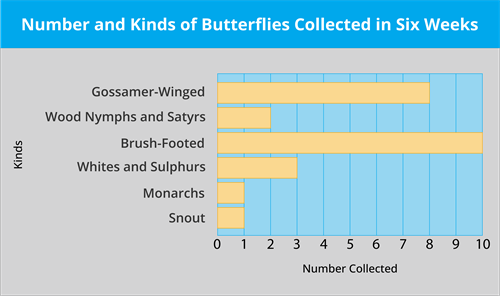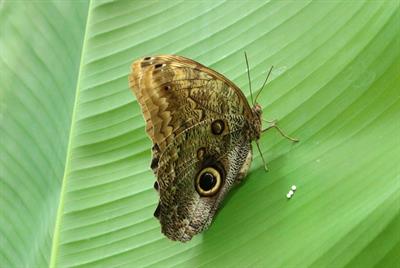
PUMPA - SMART LEARNING
எங்கள் ஆசிரியர்களுடன் 1-ஆன்-1 ஆலோசனை நேரத்தைப் பெறுங்கள். டாப்பர் ஆவதற்கு நாங்கள் பயிற்சி அளிப்போம்
Book Free Demo At the end of the book, readers were invited to help study butterfly migrations. They were asked to tag butterflies for research by Dr Frederick A. Urquhart of the University of Toronto, Canada. Ebright’s mother wrote to Dr Urquhart, and soon Ebright was attaching light adhesive tags to the wings of monarchs. Anyone who found a tagged butterfly was asked to send the tag to Dr Urquhart.
The butterfly collecting season around Reading lasts six weeks in late summer. (See graph below.) If you’re going to chase them one by one, you won’t catch very many. So the next step for Ebright was to raise a flock of butterflies. He would catch a female monarch, take her eggs, and raise them in his basement through their life cycle, from egg to caterpillar to pupa to adult butterfly. Then he would tag the butterflies’ wings and let them go. For several years his basement was home to thousands of monarchs in different stages of development.

“Eventually I began to lose interest in tagging butterflies. It’s tedious and there’s not much feedback,” Ebright said. “In all the time I did it,” he laughed, “only two butterflies I had tagged were recaptured — and they were not more than seventy-five miles from where I lived.”
Explanation:
At the end of the children's text that Ebright's mom had brought him, it was mentioned that the readers who were reading the book were invited to help study butterfly migrations. Dr Frederick A. Urquhart (a Canadian zoologist) asked them (people reading the book) to tag butterflies for research at the University of Toronto in Canada.
After reading it, Ebright's mother wrote a letter to the zoologist regarding sending tags. Very soon, Ebright attached light sticky tags to the wings of monarchs. The reason behind attaching the sticky tags was that they should not fall from them. In addition to that, it was mentioned that if anyone sees the tagged butterfly, they can send the tag to Dr. Urquhart.
The narrator then says that the butterfly collecting can only be done in the last six weeks of the summer. One can find the butterflies in the summer of Pennsylvania during June, July and August. While the summer season goes on and the autumn begins, the butterflies would migrate to Central America. So, Ebright used to collect the butterflies during his summer holidays.
Ebright then realised that if he continued to collect butterflies one by one, he would never be able to collect enough. As a result, he chose to nurture a swarm of butterflies in his basement as his next move. He used to catch a female butterfly, harvest her eggs, and raise them through their life cycles in his basement. After that, he would tag the butterflies' wings and release them. Thousands of monarchs (butterflies) grew up in his basement for several years, at various stages of development.
After reading it, Ebright's mother wrote a letter to the zoologist regarding sending tags. Very soon, Ebright attached light sticky tags to the wings of monarchs. The reason behind attaching the sticky tags was that they should not fall from them. In addition to that, it was mentioned that if anyone sees the tagged butterfly, they can send the tag to Dr. Urquhart.
The narrator then says that the butterfly collecting can only be done in the last six weeks of the summer. One can find the butterflies in the summer of Pennsylvania during June, July and August. While the summer season goes on and the autumn begins, the butterflies would migrate to Central America. So, Ebright used to collect the butterflies during his summer holidays.
Ebright then realised that if he continued to collect butterflies one by one, he would never be able to collect enough. As a result, he chose to nurture a swarm of butterflies in his basement as his next move. He used to catch a female butterfly, harvest her eggs, and raise them through their life cycles in his basement. After that, he would tag the butterflies' wings and release them. Thousands of monarchs (butterflies) grew up in his basement for several years, at various stages of development.

Eggs of butterfly
The below graph represents the number of butterflies collected in six weeks.
The below graph represents the number of butterflies collected in six weeks.
- Gossamer-winged-8
- Wood Nymphs and Satyrs-2
- Brush footed- 10
- White and sulphurs-3
- Monarch-1
- Snout-1
Ebright lost interest in tagging the butterflies, and he became bored after performing the same thing repeatedly. Furthermore, he received no adequate reaction from the biologist regarding the tags he sent. He would laugh while tagging butterflies (in the way of feeling sad and hopeless). It suggests that he didn't get the appropriate approach from the zoologist. Furthermore, just two of the butterflies he had tagged had been recaptured by humans, and they were only 75 miles distant from his house.
Meanings of the difficult words:
| S.No | Words | Meanings |
1 | Migration | The process of animals or birds travelling to a different place, usually when the season changes |
2 | Research | A detailed study of a subject, especially in order to discover (new) information or reach a (new) understanding |
3 | Monarch | A large migratory orange and black butterfly that occurs mainly in North America |
4 | Tag | A label attached to someone or something for identification or to give other information |
5 | Adhesive | Able to stick fast to a surface or object; sticky |
6 | Caterpillar | The larva of a butterfly or moth, which has a segmented wormlike body with three pairs of actual legs and several pairs of appendages similar to legs |
7 | Pupa | An insect in its inactive immature form between larva and adult |
8 | Adult | Fully grown or developed |
9 | Tedious | Boring and tiring, esp. because long or often repeated |
10 | Recapture | To take something into your possession again, especially by force |
Reference:
National Council of Educational Research and Training (2007). The Making of a Scientist- Robert W. Peterson(pp. 32-38). Published at the Publication Division by the Secretary, National Council of Educational Research and Training, Sri Aurobindo Marg, New Delhi.